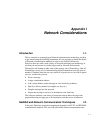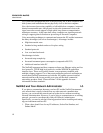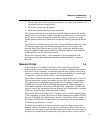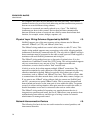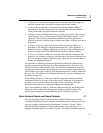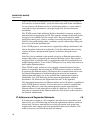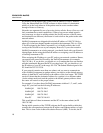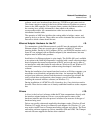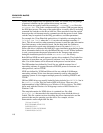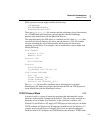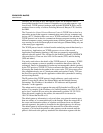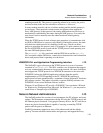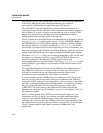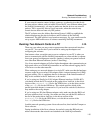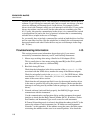
Network Considerations
Network Primer
I
I-9
software sends out a broadcast frame that every TCP/IP host and router receives.
This frame contains a request for the host with the unknown IP address to return a
frame to the ARP requester. This response frame contains the Ethernet address of
the sourcing host, and this information is then added to the address
correspondence table. All communication with a host can then be done with
information from the table.
The operation of ARP also initializes the routing tables in bridges, routers, and
gateway devices on the net. These tables are used to determine the section of the
network to which a frame should be sent.
Ethernet Adapter Hardware for the PC I-9.
To communicate via the Ethernet network, each PC must be equipped with an
Ethernet adapter. There are several types of adapters available (i.e. internal
interface boards, Parallel to LAN Adapters (PLAs), and PCMCIA interface cards.)
Some PCs are equipped with an Ethernet adapter by the manufacturer, but most
adapters must be added after purchase.
Installation of an Ethernet adapter is quite simple. The 264XA-801 card, available
as an option to the NetDAQ instruments is supplied with a small software package
that investigates the current configuration of the PC and sets the card so there is
no interference with other hardware and software. Windows 95 and Windows NT
can install commonly used adapters without using the adapter’s installation
software.
During the installation of an internal interface board on an ISA bus computer, you
must make several detailed configuration decisions. An interrupt line (IRQ) is
assigned, port addresses selected, and the network connection type selected. Be
sure to record these configuration values because you will need them when
installing the network interface software (on Windows 3.1).
During installation of a PCMCIA or PLA interface, few, if any decisions need to
be made. These devices make use of already established interfaces to the computer
bus.
Drivers I-10.
A driver is the low-level software within the PC that communicates directly with
the interface adapter hardware. Drivers cover up the specific nature of the
hardware interface and allow the protocol software to be unaware of the type of
hardware being used.
Drivers are usually written and supplied by the adapter vendor. Windows 95 and
Windows NT supply drivers for commonly used adapters. On Windows 3.1, you
may need to install Newt or Trumpet networking software and a driver. The Newt
networking software supports two driver standards: ODI and NDIS. The Trumpet
network software supports the Packet driver standard.



